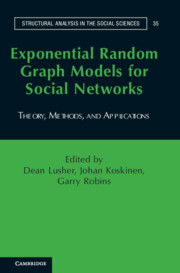Book contents
- Frontmatter
- Contents
- List of Figures
- List of Tables
- 1 Introduction
- Section I Rationale
- Section II Methods
- Section III Applications
- 14 Personal Attitudes, Perceived Attitudes, and Social Structures: A Social Selection Model
- 15 How To Close a Hole: Exploring Alternative Closure Mechanisms in Interorganizational Networks
- 16 Interdependencies between Working Relations: Multivariate ERGMs for Advice and Satisfaction
- 17 Brain, Brawn, or Optimism? Structure and Correlates of Emergent Military Leadership
- 18 Autologistic Actor Attribute Model Analysis of Unemployment: Dual Importance of Who You Know and Where You Live
- 19 Longitudinal Changes in Face-to-Face and Text Message–Mediated Friendship Networks
- Chapter 20 Differential Impact of Directors’ Social and Financial Capital on Corporate Interlock Formation
- 21 Comparing Networks: Structural Correspondence between Behavioral and Recall Networks
- Section IV Future
- References
- Index
- Name Index
16 - Interdependencies between Working Relations: Multivariate ERGMs for Advice and Satisfaction
Published online by Cambridge University Press: 05 April 2013
- Frontmatter
- Contents
- List of Figures
- List of Tables
- 1 Introduction
- Section I Rationale
- Section II Methods
- Section III Applications
- 14 Personal Attitudes, Perceived Attitudes, and Social Structures: A Social Selection Model
- 15 How To Close a Hole: Exploring Alternative Closure Mechanisms in Interorganizational Networks
- 16 Interdependencies between Working Relations: Multivariate ERGMs for Advice and Satisfaction
- 17 Brain, Brawn, or Optimism? Structure and Correlates of Emergent Military Leadership
- 18 Autologistic Actor Attribute Model Analysis of Unemployment: Dual Importance of Who You Know and Where You Live
- 19 Longitudinal Changes in Face-to-Face and Text Message–Mediated Friendship Networks
- Chapter 20 Differential Impact of Directors’ Social and Financial Capital on Corporate Interlock Formation
- 21 Comparing Networks: Structural Correspondence between Behavioral and Recall Networks
- Section IV Future
- References
- Index
- Name Index
Summary
Multirelational Networks in Organizations
A relationship between two people may occur for several reasons: working on the same project, physical proximity to one another, shared interests, or disagreements over a task. Yet, it is not just that different processes can lead to creation of one type of social tie – indeed, the connections of individuals comprise multiple types of ties simultaneously. Clearly, people negotiate many types of relationships in their everyday lives. Different relationships entail different meanings – for instance, friendship and advice are unlikely to be regarded as synonymous. Moreover, a social connection between two people may involve many different facets, each of which can be usefully analyzed as a separate type of relational tie. For instance, a relationship between two individuals may involve both working collaboration and social support. These different types of relational ties may tend to be aligned in a relationship – a person may seek advice from a friend – or even exchanged – one person might deliver a service while the other provides a payment.
Focusing on only one type of relational tie may disregard important information about the complexity of social life, and doing so may also yield an incomplete representation of individuals’ embeddedness in social settings (e.g., those provided by the structure of an organization). As Nohria suggested, “From a network perspective, […] the structure of any organization must be understood and analyzed in terms of multiple networks of relationships in the organization (both prescribed and emergent) and how they are patterned, singly and in various combinations” (1992, 5). Similarly, Kenis and Knoke argued that “No single type of relationship constitutes ‘the’ network of an organizational field. Multiple types of ties may be relevant in constructing an explanation of structure and action. Which types of networks an analyst should take into account and which ones he or she can safely ignore ultimately depend on the substantive issues driving a specific empirical inquiry” (2002, 276). The different relational ties in which an actor is embedded are typically not independent of each other. Instead, it is more realistic to assume that ties are characterized by manifold interdependencies (Lazega & Pattison, 1999; Rank, Robins, & Pattison, 2010). Relational ties may either co-occur between two individuals or one type of tie may be regarded as an antecedent to another type of tie.
- Type
- Chapter
- Information
- Exponential Random Graph Models for Social NetworksTheory, Methods, and Applications, pp. 213 - 225Publisher: Cambridge University PressPrint publication year: 2012
- 2
- Cited by

